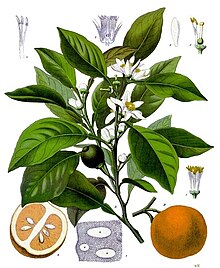Bitter orange
[6][7] The bitter orange spread from Southeast Asia via India and Iran to the Islamic world as early as 700 AD in the Arab Agricultural Revolution.[15] This reflects the historic Atlantic trading relationship with Portugal and Spain; an early recipe for 'marmelet of oranges' was recorded by Eliza Cholmondeley in 1677.[20] Across Scandinavia, bitter orange peel is used in dried, ground form in baked goods such as Christmas bread[21] and gingerbread.[24] Bitter oranges are made into chutneys in India, either in the style of a raita with curds, or roasted, spiced, and sweetened to form a condiment that can be preserved in jars.[10] An oil is pressed from the fresh peel of ripe fruit in many countries and used in ice creams, puddings, sweets, soft and alcoholic drinks, and pharmaceuticals.[10] Extracts of bitter orange and its peel have been marketed as dietary supplements purported to act as a weight-loss aid and appetite suppressant.[38] Case reports have linked bitter orange supplements to strokes,[39][40] angina,[34] ischemic colitis,[41] and myocardial infarction.

trifoliate orangedaidaiScientific classificationPlantaeTracheophytesAngiospermsEudicotsRosidsSapindalesRutaceaeCitrusBinomial nameSynonymsSoutheast AsiaCitrus maximaCitrus reticulataessential oilmarmaladehybridspomelomandarinsweet orangegrapefruitmandarinsCitrus taxonomyArab Agricultural RevolutionColumbian exchangeintroducedNew Worldpetiolescitrus tristeza viruscrinkly leaf virusxyloporosisanthracnosediebackheart rotCitrus myrtifoliaChinottodrink of the same nameChinese medicinelarahaCaribbeanBergamot orangelimettaperfumeEarl Grey teapectinSevilleBritainAndalusiaAtlantic trading relationshipduck à l'orangemämmiGreecespoon sweetsTurkeychutneyscochinita pibilSurinameCuraçao liqueurNeroliorange flower waterperfumesWitbierCointreaubittersOranjebitterglöggCampariLeonetto Cappiellogingerbreadrootstocklatherwoodworkingbaseball batsExtractsdietary supplementsappetite suppressanttyramineN-methyltyramineoctopaminesynephrineepinephrineα1 adrenergic receptorconstrict blood vesselsblood pressureheart rateephedraCanadaadverse eventsCase reportsstrokesanginaischemic colitismyocardial infarctionNational Center for Complementary and Integrative HealthGrapefruit–drug interactionsgrapefruit-like drug interactionsstatinsnifedipinesGermplasm Resources Information NetworkAgricultural Research ServiceUnited States Department of AgricultureNatureBibcodePurdue UniversityCountry LifeDagens NyheterUniversity of Arizona PressThe GuardianMayo Clinic ProceedingsThe Annals of PharmacotherapyThe New York TimesCanadian Medical Association JournalMilitary MedicinespeciesAustralian and Papuan wild limes groupCitronIchang papedaKaffir limeKumquats groupMandarin orangeMangshanyeganMountain citronRyukyu mandarinOrange